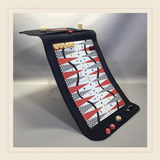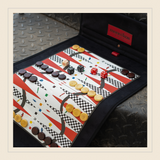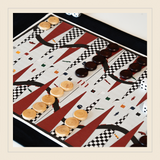AN ENTHUSIASTIC ILLUSTRATOR
Cradled by the sun and the beaches of southeastern France, this young illustrator grew up with her head full of pop colors! Today, she lives in Paris where the summer waves of her childhood constantly influence her work and her good mood. After having proven itself for other major brands, it welcomed a collaboration with Monoïkos 1297 with enthusiasm.
A NOTE OF HISTORY
The Monaco Grand Prix is one of the oldest and most prestigious races in the world.
Created in 1929 by Antony Noghès, the Monaco circuit, designed in the middle of the city, has maintained almost its entire original layout, a narrow and winding track, which makes it one of the most demanding circuits on the Formula 1 World Championship calendar.
The Monaco circuit is 3.367 km long.
The start is from the Port Hercule, then it winds through the streets of Monte Carlo and La Condamine, taking tight turns in the middle of guard rails: the track is narrow and demanding and makes overtaking difficult.
After the start line, the drivers go up the Boulevard Albert Ier and hurry through the first right-hand turn of "Sainte Dévote", the scene of many collisions in the first lap. They then start the very steep climb up "Beau-Rivage" to the very tight left-right of "Casino". From there, the drivers go down to the right turn of "Mirabeau", then comes the left hairpin "Grand Hotel", the slowest turn of the championship. The "Portier" section then leads to the sea and the drivers go through the tunnel that leads to the chicane near the port. At the exit of the tunnel, the fastest section of the circuit, the cars are approaching 300 km/h. After a short straight on the "Quai des États-Unis", comes the left turn of the "Bureau de Tabac", the left-right section of the "Piscine" and then a very difficult right hairpin at "La Rascasse". Finally, the drivers tackle the "Anthony Noghès" turn before the pit lane and the finish.
This is certainly one of the most demanding circuits on the Formula 1 World Championship calendar. It is the most glamorous, the most prestigious, the most popular and above all the one that every driver and every team wants to win!
A backgammon of exception
Our travel backgammon is entirely made in France by a passionate craftsman trained in excellence.
The game board is magnetic, exclusive, and patented. It allows you to improvise and play under any conditions without dropping the pieces. A game started outdoors can continue indoors: nothing moves!
Its size (68 x 36 cm) is comfortable for playing real games of backgammon and provides an innovative support for the designs of each of our collections.
The pieces, with a diameter of 24 mm, are made of cream and dark brown boxwood, each equipped with a magnet.
The edge of the inner pocket incorporates a metal strip for placing the pieces in waiting.
In alcantara and enhanced with red French leather finishes, our game board embodies elegance and style.
The backgammon rolls up and slips into its carrying case, also handmade in the same alcantara and enhanced with a red leather handle, the color of Monaco and our house.
The "Les Courses à Monaco" travel backgammon is part of the "Grand Prix" collection, an exceptional item that illustrates in drawings a major event of the Principality of Monaco.
RECOMMENDATION FROM MONOÏKOS 1297
Preserve the elegance of your backgammon:
• Gently roll up the game, ensuring that the board is facing outward, starting from the pocket containing the pieces without exerting excessive pressure.
• Once carefully rolled, with the illustration facing outward, insert it into its cover with care.
If the game is not used for an extended period, remove it from its cover and lay it flat to preserve its quality.
• If one of the pieces no longer sticks to the mat, it's possible that its magnet has detached and been attracted to another magnet. Retrieve it and you can reattach it with a suitable adhesive, such as super glue.
• The game should never be machine washed. In case of accidental moisture on the game surface, ensure to dry it quickly using a hair dryer, by exposing it to sunlight, or by any other appropriate means. This precaution is essential to prevent the appearance of rust spots that could compromise its quality.
• If creases appear, you can iron your game, except for the printed part, to restore its impeccable appearance.

The rules of the
BACKGAMMON
A game of Backgammon is played between two players. The game takes place on a board with 24 triangles, also known as points, alternating between two distinct colors.
Each player has 15 checkers of their own color, which they move from point to point based on the roll of two dice.
The goal is to move all of your checkers into your home board and then bear them off the board.
The winner is the first to bear off all 15 checkers.
Movement occurs from the opponent's home board to your own home board, with no backward movement allowed for either player.
To determine who starts, each player rolls one die, and the player with the higher roll plays first, using the combined value of both dice. In case of a tie, the roll is repeated, ensuring that no game starts with a double.
Each player moves their checkers according to the numbers rolled, then picks up their dice to signal the end of their turn. Moves are made independently for each die, except in the case of a double, where four moves are made.
A checker can land on an empty point, a point occupied by the player's own checkers, or a point occupied by a single opposing checker, resulting in a hit. (In the event of a hit, the opponent's checker is placed on the bar and must re-enter the game in the opponent's home board.)
A checker cannot land on a point occupied by two or more opposing checkers. A point occupied by two or more checkers of the same player is called a block. The opponent cannot land on or pass through a blocked point but can jump over it. Note: There is no limit to the number of checkers of the same color on a single point.
The bearing-off phase, the final stage of the game, begins once all of a player's checkers are in their home board. Each die allows a checker to be borne off from the corresponding point, unless there is no checker on that point, in which case the player must make another legal move. There are two cases:
Bearing off a checker is not mandatory if it can be replaced by the legal movement of another checker. As before, doubles are played twice (four moves).
The stakes vary depending on the bearing off and the game situation:
If the losing player has not borne off any checkers but has no checkers in the opponent's home board or on the bar, the game is declared a gammon or double, and the winner scores two points (or twice the value indicated by the doubling cube).
If the losing player has not borne off any checkers and still has one or more checkers in the opponent's home board or on the bar, the game is declared a backgammon or triple, and the winner scores three points (or three times the value indicated by the doubling cube).
A checker hit and placed on the bar:
There is no limit to the number of checkers on the bar. A checker on the bar re-enters the game by landing in the opponent's home board (points 1 to 6) based on the roll of the dice: a 1 allows entry on the opponent's 1-point, a 2 on the 2-point, etc., provided the entry point is not occupied by a block. If a player has one or more checkers on the bar, they must re-enter all of them before making any other move. If the dice do not allow this, the player must pass their turn.
The doubling cube:
A six-sided cube (2, 4, 8, 16, 32, and 64) is used to increase the stakes of the game. At the start of each game, the doubling cube is placed on the bar or the side of the board, indicating that the game's stake is one point. To double the stake, a player must wait for their turn and do so before rolling the dice. They then present the cube to their opponent with the top face showing the value 2, saying "I double" or an equivalent phrase.
Its use can be accepted or declined by the opponent, affecting the course of the game.
Later in the game, the player who accepted the double becomes the owner of the cube and is the only one who can redouble to 4, following the same procedure as the initial double. If the redouble is accepted, the new owner will be the only one able to redouble to 8, and so on.
The match:
A match is played until one player reaches a predetermined odd number of points. Points are awarded at the end of each game based on the results, and the first player to reach the required number wins the match, following the Crawford rule.
This rule states that if one player is one point away from winning, the doubling cube cannot be used in that game.





